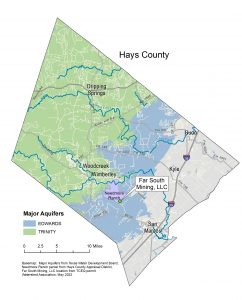 Trinity Edwards Springs Protection Association (TESPA) has issued a notice of intent to take legal action protesting the proposed Far South Mining LLC TCEQ permit to stop the proposed quarry and rock crushing plant on the Needmore Ranch. The Watershed Association has a long history of collaborating and supporting TESPA through the Water Protectors Fund, the Electro Purification Permit Protest, and the Needmore Ranch Water Permit. Details about the protest are available in the TESPA Press Release issued May 16, 2022:
Trinity Edwards Springs Protection Association (TESPA) has issued a notice of intent to take legal action protesting the proposed Far South Mining LLC TCEQ permit to stop the proposed quarry and rock crushing plant on the Needmore Ranch. The Watershed Association has a long history of collaborating and supporting TESPA through the Water Protectors Fund, the Electro Purification Permit Protest, and the Needmore Ranch Water Permit. Details about the protest are available in the TESPA Press Release issued May 16, 2022:
WIMBERLEY, TX The Trinity Edwards Springs Protection Association (TESPA) has sent the attached Notice of Intent (NOI) to sue Far South Mining LLC to stop the proposed quarry and rock crushing plant on the Needmore Ranch between Wimberley and San Marcos in Hays County, TX.
The legal action seeks to protect groundwater in the Edwards Aquifer Authority’s jurisdictional “red zone,” and to protect endangered species living in the karst aquifer that flows out at Fern Bank Springs into the Blanco River and nearby San Marcos Springs. TESPA seeks to protect the water and endangered species through the Endangered Species Act, Clean Water Act, and Edwards Aquifer Protection Plan.
At issue are concerns that the rock quarry and rock crushing operation will likely cause “take” of several endangered species—the Comal Springs Dryopid Beetle, Golden-cheeked Warbler, San Marcos Springs Salamander, and Texas Blind Salamander—in addition to water pollution in one of the best aquifers in Texas.
“TESPA is taking this action in our role to protect and preserve our groundwater, aquifers, springs, the Blanco River, and this area of the Hill Country,” stated TESPA Executive Director Patrick Cox, Ph.D. “Far South Mining LLC’s proposed quarry and rock crushing operation on the Needmore Ranch pose real threats to federally protected endangered species and their designated critical habitat, and to this very sensitive aquifer and groundwater. This proposed operation should be immediately canceled.”
TESPA’s NOI letter clearly lays out the threats and irreparable harms that will result from the proposed rock mining and crushing operation, such as:
- lowering of local groundwater and surface water levels from mining operations and dewatering,
- changes in turbidity levels in groundwater/surface water due to blasting and quarry operation,
- interruption of groundwater conduit flow paths by rock removal and/or blasting in karst systems,
- temperature change (thermal impacts) in springs and surface water streams,
- seismic impacts to endangered species,
- impacts to groundwater/surface water quality from hazardous chemical spills and blasting residuals,
- impacts from point and nonpoint sources of dust to surface water and groundwater from stormwater runoff and fugitive dust,
- destruction of sensitive superficial karst features, such as caves,
- disruption of natural drainage patterns and stream morphology,
- pollution from residues of nitrates and petroleum products accumulating in the stormwater runoff and groundwater from the ammonium nitrate blasting slurry and related activities, and
- leaks and spills of petroleum products from equipment as well as the risk of outright spills.
In short, TESPA seeks to prevent Far South Mining LLC (FSM) from moving ahead with its proposed quarry operations on 185 acres with activities that involve blasting, operation of heavy equipment, rock crushing, and the transport of an estimated 100+ truckloads of rock per day in Hays County, Texas, between Wimberley and San Marcos on the Needmore Ranch, formerly known as “Little Arkansas.” The Needmore Ranch is also home Fern Bank Springs, which is designated as “critical habitat” under the Endangered Species Act for a federally endangered species, the Comal Springs Dryopid Beetle.
TESPA’s attorney, Jeff Mundy said, “Texas has the most polluted water in the United States. This area of the Edwards Aquifer is some of the best quality water remaining in the state. When I was a boy, we camped, swam and drank the water straight from the Blanco River. We must protect our rivers, aquifers and groundwater so future generations have the same opportunities for clean, safe water.”
Coverage and links to water protection efforts:
-
- Water, Mud, and Beer: Recipe for an Explosive Hill Country Development, Texas Observer, May 2013
- Water war boils back up: Legislation may roll back groundwater protections, Hays Free Press, March 2017
- Living with Karst: Watershed Association and TESPA Education Initiative
- Water Protectors Fund: Science, Education, Policy and Legal Support
Attachments
Media Contact:
Patrick Cox, PhD., TESPA Executive Director, patrickcox7@gmail.com